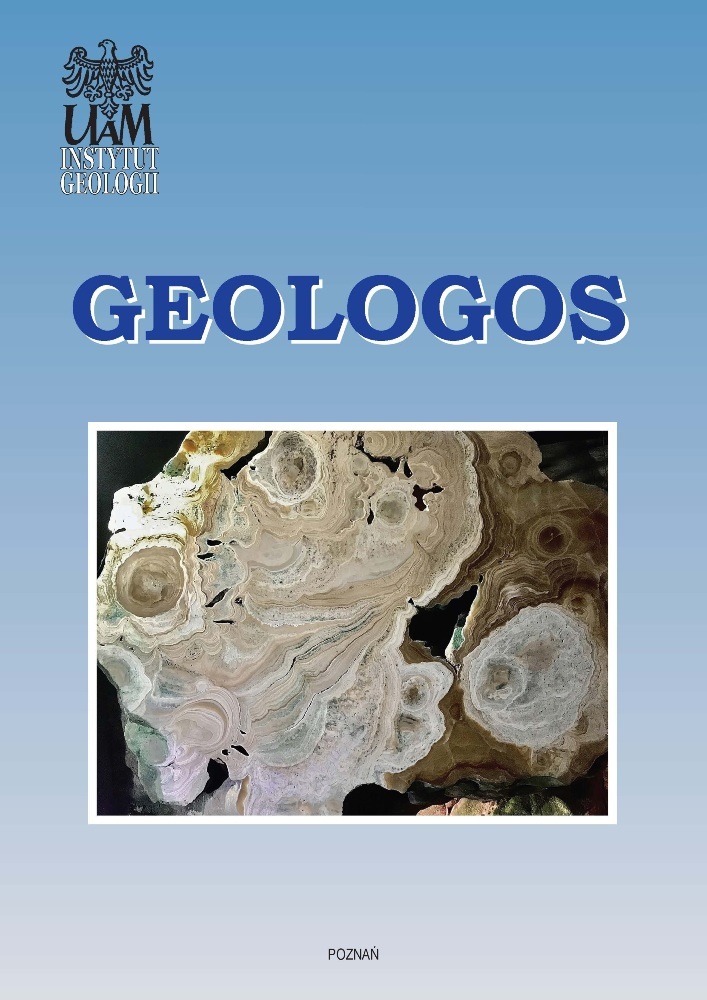Abstract
A comparison of two methods of radiocarbon age determination of groundwater is presented. The simplest Pearson model and the “user-defined” option of the NETPATH program were considered. Both methods were used to determine the age of water from a PZ-2 piezometer that is situated in the foreground of chamber Z-32 in Wieliczka Salt Mine. Results of these calculations clearly demonstrate that 14C ages obtained by the Pearson model can be significantly overestimated in comparison with those determined by the NETPATH code. Without additional data, such as the stable isotope composition of the water, conclusions on the age of the groundwater based solely on the Pearson model may be highly inadequate.
References
d’Obyrn, K. & Postawa, A., 2013. Selected hydrochemical ratios of waters from inflows at the level VI in “Wieliczka” salt mine. Geology, Geophysics and Environment 39, 163–174.
d’Obyrn, K. & Postawa, A., 2014. Assessment of the qualitative and quantitative stability of “Wieliczka” Salt Mine (Poland) brines and of their possible use for medical purposes. Geological Quarterly 58, 459–464.
d’Obyrn, K. & Rajchel, L., 2014. Balneologiczne walory Kopalni Soli „Wieliczka” [Balneological values of the Wieliczka Salt Mine]. Acta Balneologica 61, 220–223.
Duliński, M., Rozanski, K., Kuc, T., Gorczyca, Z., Kania, J. & Kapusta, M., 2013. Evolution of radiocarbon in a sandy aquifer cross large temporal and spatial scales: case study from southern Poland. Radiocarbon 55, 905–919.
Garrels, R.M., 1960. Mineral Equilibria at Low Temperature and Pressure. Harper & Brothers Publishers, New York, 254 pp.
Gorczyca, Z., 2003. Badania zmienności składu izotopowego strumienia glebowego dwutlenku węgla do atmosfery na obszarze Polski południowej [Variability of the isotope composition of the soil CO2 flux to the atmosphere in the Southern Poland]. University of Science and Technology, Kraków, 169 pp.
Han, L.F. & Plummer, L.N., 2016. A review of single-sample-based models and other approaches for radiocarbon dating of dissolved inorganic carbon in ground-water. Earth-Science Reviews 152, 119–142.
Kapusta, M., 2012. Datowanie wód podziemnych z wykorzystaniem radiowęgla – zagadnienia metodyczne i zastosowanie [Dating groundwater using radiocarbon – methodological issues and application]. University of Science and Technology, Kraków, 88 pp.
Libby, W.F., 1946. Atmospheric helium three and radio-carbon from cosmic radiation. Physical Review 69, 671–672.
Pearson, F.J.Jr., 1965. Use of C13/C12 ratios to correct radiocarbon ages of materials initially diluted by limestone. Proceedings of the 6th International Conference on Radiocarbon and Tritium Dating, Pullman, USA, 357–366.
Plummer, L.N., Prestemon, E.C. & Parkhurst, D.L., 1991. An interactive code (NETPATH) for modeling NET geo-chemical reactions along a flow PATH. Water-Resources Investigations Report 91-4078, U.S. Geological Survey, Reston, 130 pp.
Witczak, S., d’Obyrn, K., Duliński, M. & Rajchel, L., 2016. Warunki zasilania wód leczniczych w Kopalni Soli Wieliczka [Conditions of medicinal water supply in the Wieliczka Salt Mine]. Biuletyn Państwowego Instytutu Geologicznego 466, 313–322.
Zuber, A. & Rajchel, L., 2007. Geneza wód mineralnych Matecznego, Kraków [Origin of mineral waters in Kraków-Mateczny]. [In:] A. Szczepański, E. Kmiecik & A. Żurek (Eds): Współczesne problemy hydrogeologii XIII [Contemporary Problems of Hydrogeology XIII]. University of Science and Technology, Kraków, 995–1002.
License
Copyright (c) 2019 Marek Duliński, Zbigniew Gorczyca, Michał Marzec, Robert Czub, Krzysztof Brudnik

This work is licensed under a Creative Commons Attribution-NonCommercial-NoDerivatives 3.0 Unported License.
